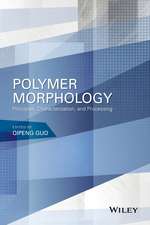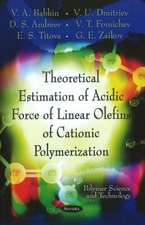Theoretical Aspects of Heterogeneous Catalysis: Van Nostrand Reinhold Electrical/Computer Science and Engineering Series
Autor John B. Moffaten Limba Engleză Paperback – 20 iun 2012
Preț: 401.42 lei
Nou
Puncte Express: 602
Preț estimativ în valută:
76.81€ • 80.40$ • 63.93£
76.81€ • 80.40$ • 63.93£
Carte tipărită la comandă
Livrare economică 31 martie-14 aprilie
Preluare comenzi: 021 569.72.76
Specificații
ISBN-13: 9789401098847
ISBN-10: 9401098840
Pagini: 552
Ilustrații: XVI, 616 p. 48 illus.
Dimensiuni: 152 x 229 x 32 mm
Greutate: 0.73 kg
Ediția:Softcover reprint of the original 1st ed. 1990
Editura: SPRINGER NETHERLANDS
Colecția Springer
Seria Van Nostrand Reinhold Electrical/Computer Science and Engineering Series
Locul publicării:Dordrecht, Netherlands
ISBN-10: 9401098840
Pagini: 552
Ilustrații: XVI, 616 p. 48 illus.
Dimensiuni: 152 x 229 x 32 mm
Greutate: 0.73 kg
Ediția:Softcover reprint of the original 1st ed. 1990
Editura: SPRINGER NETHERLANDS
Colecția Springer
Seria Van Nostrand Reinhold Electrical/Computer Science and Engineering Series
Locul publicării:Dordrecht, Netherlands
Public țintă
ResearchCuprins
1 A Theoretical View and Approach to the Physics and Chemistry of Zeolites and Molecular Sieves.- Quantum Mechanical Description of Al-Site-Related Properties in Zeolites.- Statistical Mechanics and Molecular Dynamics Simulations Applied to a Water-Ferrierite System.- 2 Conceptual Background for the Conversion of Hydrocarbons on Heterogeneous Acid Catalysts.- Nomenclature and Representation of Alkylcarbenium and Alkylcarbonium Ions Relevant to Alkane Conversion.- Relative Stabilities of Alkylcarbenium and Alkylcarbonium Ions.- Rearrangements of Acyclic Alkylcarbenium Ions in Superacids.- Alkylcarbenium Ions on the Surface of Heterogeneous Catalysts.- Carbocation Chemistry and Bifunctional Conversion of Short-Chain Alkanes.- Carbocation Chemistry and Bifunctional Conversion of Long-Chain Alkanes.- General Conclusions.- 3 The Role of Next Nearest Neighbors in Zeolite Acidity and Activity.- The Aluminosilicate Active Site.- Buffered Behavior and Zeolite Structure.- Stability Criteria and the Next-Nearest-Neighbor Model.- Paraffin Cracking Activity.- Cumene Cracking Activity.- Summary and Conclusions.- 4 Electronegativity Equalization, Solid-State Chemistry, and Molecular Interactions.- Electronegativity of an Atom in a Molecule.- Explicit Expression for the Effective Electronegativity.- The Electronegativity Equalization Method (EEM).- The Solid State.- Molecular Interactions.- Framework: Intrinsic Properties.- Framework: Molecular Interactions.- Brønsted Acidity: Intrinsic Properties.- Brønsted Acidity: Molecular Interactions.- The Active Site.- 5 Quantum-Chemical Studies of Zeolites.- Zeolite Models and Quantum-Chemical Methods.- Zeolite Properties.- Interaction of Zeolite Sites with Molecules.- Conclusions.- 6 Theoretical Studies of Transition Metal SulfideHydrodesulfurization Catalysts Suzanne Harris.- Periodic Trends in the HDS Activity of Simple TMS.- Promoted TMS Catalysts.- Electronic Structure of the Simple and Promoted TMS.- Structural Effects in Layered TMS.- Active Site Theory.- Conclusions.- 7 Factors Affecting the Reactivity of Organic Model Compounds in Hydrotreating Reactions.- General Features.- Reactivity of Aromatic Molecules.- Reactivity of Saturated Molecules.- Theoretical Modeling of the Reactivity.- Conclusions.- 8 Theoretical Investigation of Metal-Support Interactions and Their Influence on Chemisorption.- Experimental Investigations of Geometric Structures and Electronic Properties of Metal-Support Systems: Support Influence on Adsorbates.- The Support Influence on Chemisorption.- Surface Modeling and Computational Methods.- Metal-Support Interfaces and Support Influence on Chemisorption: Recent Theoretical Results.- Conclusions.- Note Added in Proof.- 9 Mechanisms and Intermediates of Metal Surface Reactions: Bond-Order Conservation Viewpoint.- The BOC-MP Model of Chemisorption.- Mapping of Surface Reactions.- Concluding Remarks.- 10 Structure and Electronic Factors in Heterogeneous Catalysis: C?C, C?O, and C–H Activation Processes on Metals and Oxides.- Atom Superposition and Electron Delocalization Molecular Orbital (ASED-MO) Approach.- Studies in Bond Activation.- Acetylene Bonding to Transition Metals: Structure and Electronic Effects.- CO Binding to Transition Metal Surfaces: A New Interaction.- CO Binding to ZnO and Surface Ion Relaxations.- CH Activation in Alkanes and Alkenes.- Conclusions.- 11 Application of Band-Structure Calculations to Chemisorption.- Method of Calculation.- Atomic Adsorbates.- Molecular Stereochemistry.- CO Adsorption.- Saturated Hydrocarbons.- EthyleneAdsorption.- Chemisorbed Butadiene.- Concluding Remarks.- 12 Quantum-Chemical Studies of the Acidity and Basicity of Alumina.- Acid-Base Properties of ?-Alumina.- Structure of Acidic and Basic Sites.- Models for Molecular Orbital Calculations of Alumina.- Types of Surface Hydroxyls.- Brønsted Acidity.- Basicity.- Lewis Acidity.- Conclusions.
Recenzii
This is a useful, well written nicely produced book that covers literature published up to two or three years ago. Unfortunately it does not have a good index, but it does much to bridge theoretical developments and the more practical aspects of catalysis. Most practising catalytic scientists will find more than one section of interest - it is a volume that should be in the libraries of academic and industrial centres concerned with catalysis.























